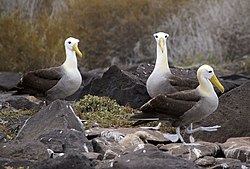North Pacific albatross
| North Pacific albatross | |
|---|---|
 |
|
| Waved albatrosses on Española Island, Galapagos | |
| Scientific classification | |
| Kingdom: | Animalia |
| Phylum: | Chordata |
| Class: | Aves |
| Order: | Procellariiformes |
| Family: | Diomedeidae |
| Genus: |
Phoebastria L. Reichenbach, 1853 |
| Species | |
|
Phoebastria immutabilis |
|
| Synonyms | |
|
Diomedea (sensu Coues, 1866) |
|
Phoebastria immutabilis
Laysan albatross
Phoebastria nigripes
Black-footed albatross
Phoebastria irrorata
Waved albatross
Phoebastria albatrus
Short-tailed albatross
†Phoebastria californica
†Phoebastria anglica
†Phoebastria rexsularum
†Phoebastria cf. albatrus
†Phoebastria cf. immutabilis
†Phoebastria cf. nigripes
Diomedea (sensu Coues, 1866)
Julietata Mathews & Hallstrom, 1943
The North Pacific albatrosses are large seabirds from the genus Phoebastria in the albatross family. They are the most tropical of the albatrosses, with two species (the Laysan and black-footed albatrosses) nesting in the Northwestern Hawaiian Islands, one on sub-tropical islands south of Japan (the short-tailed albatross), and one nesting on the equator (the waved albatross).
Their taxonomy is very confusing, as with all albatrosses. It is widely accepted now, based on molecular evidence and the fossil record, that they are a distinct genus from Diomedea in which formerly most "white" albatrosses were placed but which is now restricted to the "great" albatrosses. They share certain identifying features. First, they have nasal passages that attach to the upper bill called naricorns. Although the nostrils on the albatross are on the sides of the bill. The bills of Procellariiformes are also unique in that they are split into between seven and nine horny plates. Finally, they produce a stomach oil made up of wax esters and triglycerides that is stored in the proventriculus. This is used against predators as well as an energy rich food source for chicks and for the adults during their long flights. They also have a salt gland that is situated above the nasal passage and that helps desalinate their bodies, to compensate for the high amount of ocean water that they imbibe. It excretes a high saline solution from their nose.
...
Wikipedia
